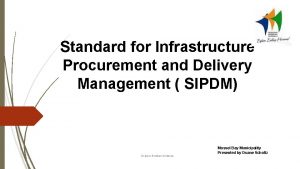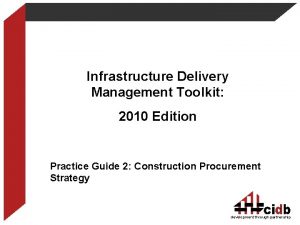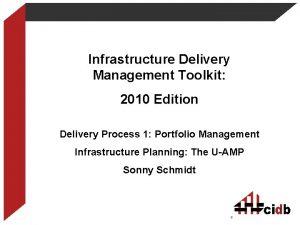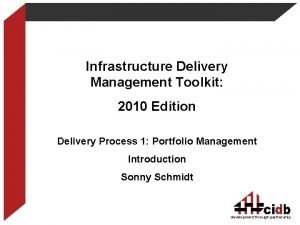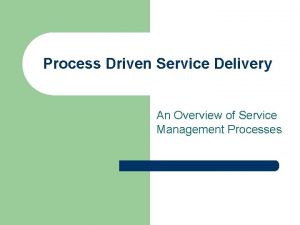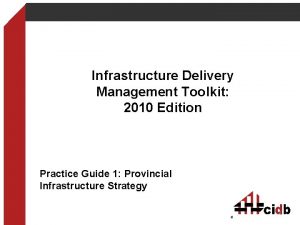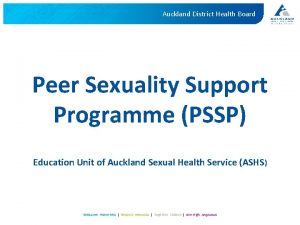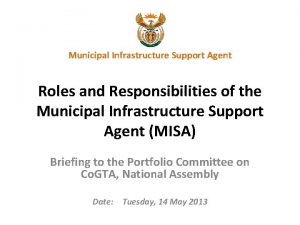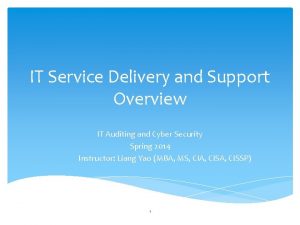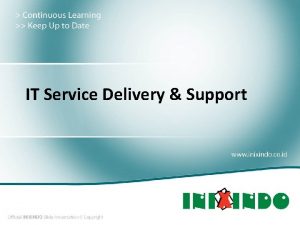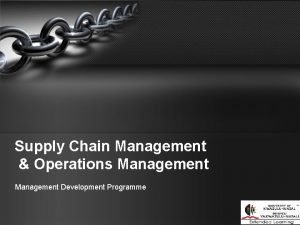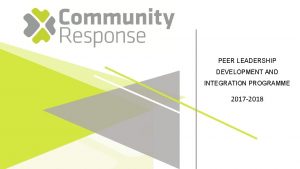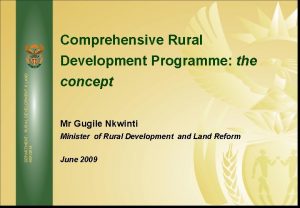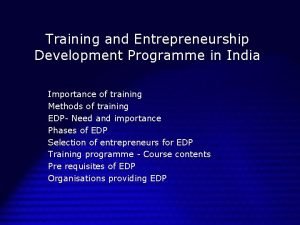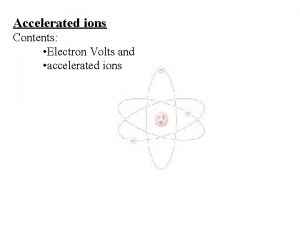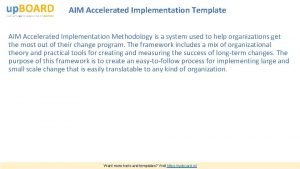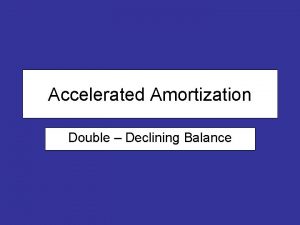SUPPORT PROGRAMME FOR ACCELERATED INFRASTRUCTURE DELIVERY DEVELOPMENT OF





















- Slides: 21

SUPPORT PROGRAMME FOR ACCELERATED INFRASTRUCTURE DELIVERY DEVELOPMENT OF A SECTORAL INFRASTRUCTURE PROCUREMENT STRATEGY Sean Phillips 25 March 2010 1

Problem Statement: why is a procurement strategy required? Improved selection of procurement strategy will result in improved delivery outcomes. n CIDB has produced a range of standards, practice notes and guides n Contain large number of options for procurement approaches and contracting options n Currently no overall guide of how to choose from myriad of available options for a particular expenditure programme n Organs of state (with some exceptions) generally only utilise time honored and familiar procurement approaches regardless of changing circumstances q q q Tend to be highly resource intensive-intensive for the client Implementing agents often cannot cope with workload using these approaches Leads to poor outcomes: under-expenditure, poor contract management 2

Development of a methodology for sector infrastructure procurement strategies A national initiative to develop a methodology for producing a social infrastructure procurement strategy has been piloted in Limpopo. n Support Programme for Accelerated Infrastructure Delivery (SPAID) q q n Joint project between BT and Presidency President’s Big Business Working Group requested BT to identify creative ways in which the public and private sectors could cooperate to support infrastructure delivery Discussions between BT, NT and DOE led to project to develop social infrastructure procurement strategy methodology q Limpopo DOE volunteered to be the test site n National steering committee: NT (PPP, IDIP, TAU), LT, LDOE, national DOE and Health, CIDB n Generic methodology has been developed and tested in Limpopo n Now being implemented in Limpopo and approach is being rolled out to other provinces (Education and Health), as part of IDIP 3

Strategic planning and investment planning The existing education infrastructure plans, planning processes and quality of underlying data in Limpopo were reviewed. n Procurement is preceded by strategic planning and investment planning q Provincial strategic planning is guided by Treasury Regulations and strategic planning guidelines q Social infrastructure investment planning is guided by CIDB Toolkit for Infrastructure Delivery Management, developed as part of NT Infrastructure Delivery Improvement Programme (IDIP) n Limpopo DOE IDIP five-year infrastructure plan was reviewed q Contains prioritised lists of projects to be funded over five years n Findings: q Logical and reasonably robust methodology q Appears to be directing expenditure towards most urgent needs q Infrastructure plan will generally not result in procurement of ‘wrong things’ q Project should proceed to next phase of developing procurement and contracting strategy to enable infrastructure plan to be procured in the right way 4

Underlying principle of the generic methodology “Procurement strategy” = Choosing the most appropriate procurement and contracting approaches to meet your objectives. n All procurement and contracting options are considered equally valid q q Methodology does not say that some approaches better than others (eg does not say that some forms of contract document are better than others) Different options are most suitable under different conditions 5

Gather information on local conditions and formulate objectives The choice of options is dependent on local conditions. n Spend and category analysis – what are the characteristics of what is being procured, from a procurement point of view? q n Organisation analysis q What capacity and approach to risk does the organisation have and wish to have? n Market analysis – what capacity is in the market? n What are the organisation’s primary procurement objectives, e. g. q q n Categorise needs in terms of types of output and other commonalities budget / cost quality and performance characteristics required from the completed work And secondary procurement objectives, e. g. q BBBEE 6

Match options to local conditions Decision tables are used to match options to local conditions. n Meeting needs through a programme of projects or a series of independent projects n Meeting needs through PPP n Meeting needs through implementing agent(s) n Meeting needs through framework agreements n Packaging of the work 7

Gather information Formulate objectives Delivery management strategy Make strategic delivery management decisions Meet needs through own organisation Meet needs through PPP Meet needs through Implementing Agent Package works Contracting strategy Decide on contracting strategy Procurement arrangements Decide on procurement arrangements Implement procurement strategy Conduct annual evaluation of infrastructure spend on projects and programmes 8

n n Identify contracting strategy per procurement category for contractors and PSPs q Contractual arrangements q Pricing strategy q Form of contract Identify procurement arrangements per procurement category for contractors and PSPs q Quality strategy q Procurement procedure q Prequalifications q Targeted procurement strategy q Tender evaluation procedure 9

Decision table for PPP 10

Decision table for framework agreements 11

Options for contracting strategy for construction services (the methodology contains decision tables for each) 12

Options for procurement arrangements for construction services 13

Application to LDOE: Spend analysis Application of the methodology LDOE’s 5 year infrastructure plan resulted in radical changes to its procurement and contracting strategies. n Identified five procurement categories and grouped the 2201 projects in the five year infrastructure plan into the five categories q q q Category 1: Office Greenfields Category (high value new buildings), managed by Head Category 2: Brownfields Upgrade and Repair Category (medium value) Category 3: Water and Sanitation Category, consisting of a mix of small civil and building projects managed by DWAF Category 4: Routine and Preventative Maintenance Category, managed in consultation with SGB’s Category 5: Electrification of schools by Eskom 14

Application to LDOE: procurement strategy Application of the methodology LDOE’s 5 year infrastructure plan resulted in radical changes to its procurement and contracting strategies. n Developed a procurement strategy for construction services for each category n Identified PSPs required and developed a procurement strategy for each type of PSP n Introduced framework agreements for small and medium-sized projects and for some professional service providers n Introduced appropriate targeted procurement procedures including preferencing, incentives and contractual obligations to meet secondary procurement objectives q Draws on Ethekwini water mains replacement experience n Introduced competitive tendering for professional service providers 15

Summary of benefits for LDOE LDo. E’s new procurement strategy will greatly reduce the workload on officials, reduce costs, and improve response times. Benefits of new procurement strategy: q q Total 95 contracts to manage over five years for 2201 projects (excluding professional service providers) Historically would have had 2201 contracts (excluding professional service providers), each with its own procurement process q q Resulted in severe strain on capacity of department and IAs and delivery problems Much quicker response times using framework contracts Officials can spend more time on strategic issues and less time on operational issues Anticipating substantial reduction in costs over current fee on cost of construction pricing strategy – potentially R 350 million over five years 16

Contractor development using framework agreements n Status of transformation in contractor market q Black owned suppliers make up > 90% suppliers at grades 1 – 5 q Supplier market at grades 1 – 5 is probably over supplied n Hence meaningful contractor development entails developing: q Black Grade 6/7 contractors to Grade 7/8 q Black Grade 3/4/5 contractors into Grade 4/5/6 using the sub-contractor & mentor model n Strategy supports meaningful contractor development programme by: q Applying preferential procurement to select Limpopo BEE contractors q Large contractors will have to meet contractual obligations n Subcontract a minimum % of work to lower grade BEE contractors n Develop black contractors through a predetermined number of grades n The 3 year framework agreement will ensure continuity of business and mentorship for the BEE suppliers, ensuring a more sustained learning curve n The CIDB register will be used to track performance and identify sub-contractors q Mentorship by experienced contractors yields best results n Similar model has been applied on the e. Thekwini contractor development programme 17

Objective is to develop more black owned contractors at higher grades National % black owned contractors Number of Limpopo contractors Grade General building 1 98% 5011 2 94% 253 3 95% 65 4 89% 81 5 89% 75 6 79% 61 7 67% 19 8 51% 0 9 12% 0 Total Develop Grade 3/4/5 contractors into Grade 4/5/6 using the sub-contractor & mentor model Develop Grade 6/7 contractors to Grade 7/8 5565 Medium sized contractors > 80% black ownership 18

Implications of changes n Does not require any special approvals from Treasury – allowable in terms of the existing SCM and CIDB frameworks n In-sources professional expertise (apart from programme management) q IA’s do not need large numbers of engineers, architects, QS, or project managers q Just needs small number of open-minded programme managers willing to familiarise themselves with various contracting and procurement approaches and forms of contract n Envisaged challenges to rolling out a new approach to social infrastructure procurement q Client difficulty in deciding on objectives q Resistance to change, particularly from professional service providers 19

Broader roll-out SPAID is working with NT, n. DOE, n. Health and CIDB to roll out the approach in the social sector. n National workshops to be held this year n One-on-one engagements with key national stakeholders n Integration into IDIP q IDIP technical assistants will help provincial health and education departments to implement the methodology 20

THANK YOU 21
 Infrastructure procurement and delivery management
Infrastructure procurement and delivery management Infrastructure delivery management
Infrastructure delivery management Infrastructure delivery management toolkit
Infrastructure delivery management toolkit Infrastructure delivery management toolkit
Infrastructure delivery management toolkit Infrastructure delivery management system
Infrastructure delivery management system Service delivery process definition
Service delivery process definition Infrastructure delivery management system
Infrastructure delivery management system Remedial teaching is employed
Remedial teaching is employed Benazir bhutto income support programme watan card
Benazir bhutto income support programme watan card Peer sexuality support programme
Peer sexuality support programme Municipal infrastructure support agent
Municipal infrastructure support agent Components of accenture delivery suite (ads)
Components of accenture delivery suite (ads) It service delivery and support
It service delivery and support It service delivery and support
It service delivery and support Bbsdp
Bbsdp What is krishi darshan
What is krishi darshan Logistics strategy triangle
Logistics strategy triangle Jawahar gram samridhi yojana
Jawahar gram samridhi yojana Peer leadership development programme
Peer leadership development programme Comprehensive rural development programme
Comprehensive rural development programme Feedback for faculty development programme
Feedback for faculty development programme Importance of edp
Importance of edp
